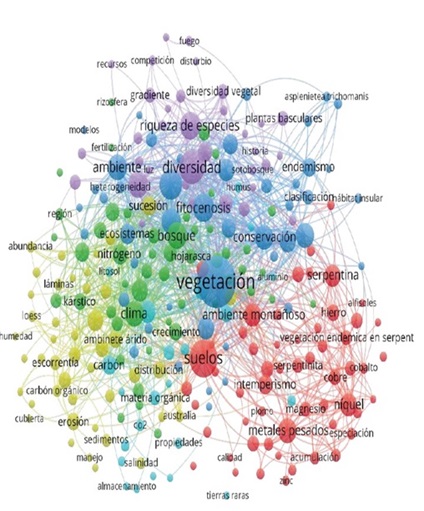Desempeño y Mapeo de la Producción Científica de la Relación Roca-Suelo-Vegetación
DOI:
https://doi.org/10.28940/terra.v42i.2022Palabras clave:
análisis bibliométrico, edafogénesis, clústeres, colaboración académicaResumen
La relación entre roca, suelo y vegetación es fundamental. Los suelos, formados por intemperismo y erosión de rocas e influenciados por procesos edáficos (carbonatación, gipsificación, salinización, entre otros) proporcionan el sustrato esencial para la vida vegetal. Por lo tanto, el propósito fue medir el desempeño de la producción científica respecto a la relación entre roca, suelo y vegetación. Este estudio busca comprender el enfoque científico que se ha dado a este tema, evolución y posibles áreas de investigación futura, por ejemplo: génesis de suelos, taxonomía, plantas calcícolas, seleníferas, gipsófilas. Este análisis bibliométrico abarca la producción científica desde 1935 hasta 2023, indexada en la base de datos Web of Science. Se analizaron 276 trabajos científicos utilizando indicadores bibliométricos uni y multidimensionales. Fue notable que 28% de estos documentos (77 en total) se publicaron en los últimos cuatro años, lo que indica un crecimiento importante en este tema. Los países con mayor contribución fueron Estados Unidos (19.6%), China (18.1%), Francia (8.3%), Brasil (7.6%) y Australia (6.2%). La revista Catena lideró la producción de estos trabajos y el autor más destacado fue Wang Kelin. Las principales temáticas de la relación roca-suelo-vegetación se centraron en: adaptación vegetal a suelos contaminados por metales pesados, disponibilidad de nutrientes, relación entre la vegetación y la roca, restauración, diversidad vegetal y, contenido de materia orgánica en el suelo. Este análisis pone de manifiesto las fuentes de interés en el estudio de esta relación, además de las mencionadas en el párrafo anterior, roca y calidad del suelo generado, capacidad de uso, uso potencial para ciertas plantas, entre otros.
Descargas
Publication Facts
Reviewer profiles N/D
Author statements
- Academic society
- Terra Latinoamericana

















